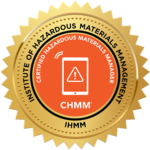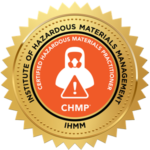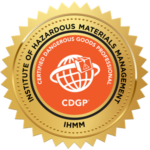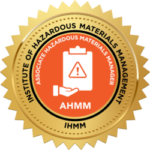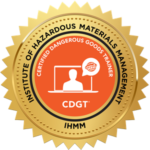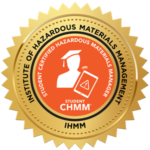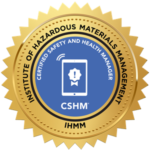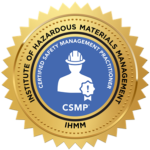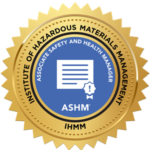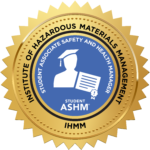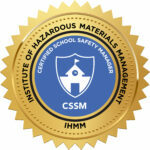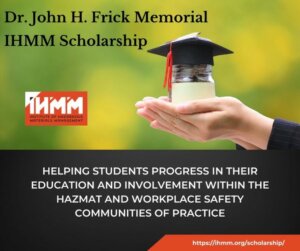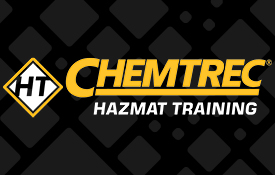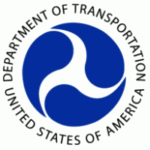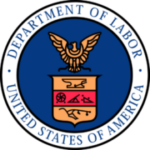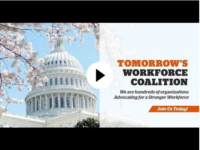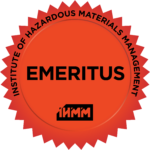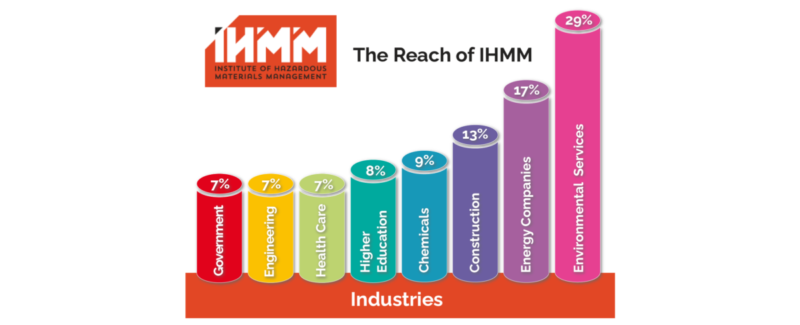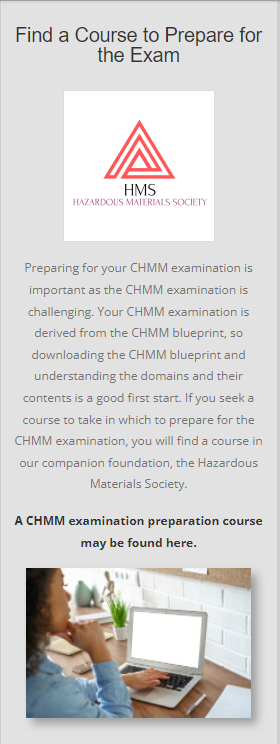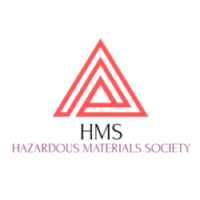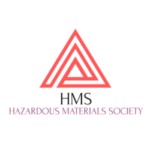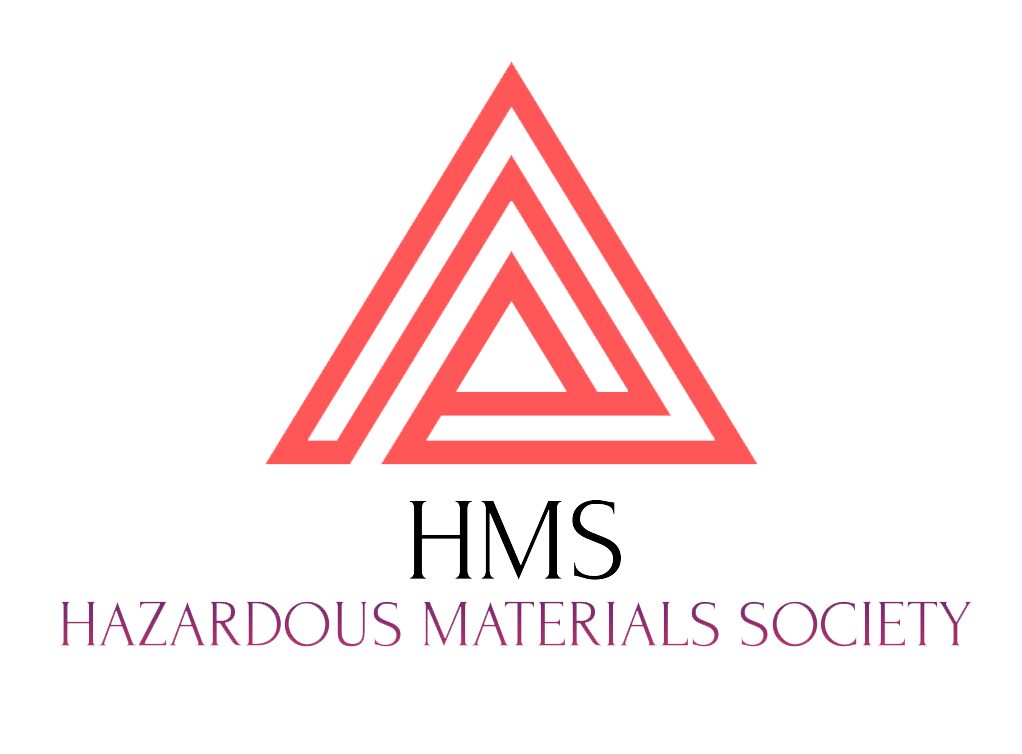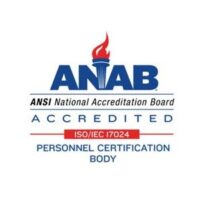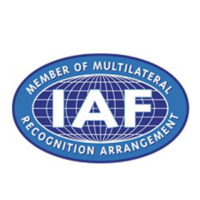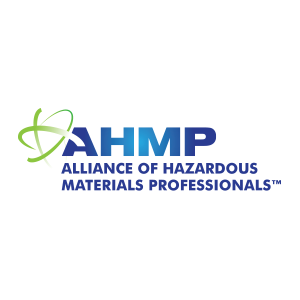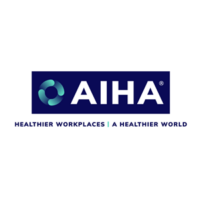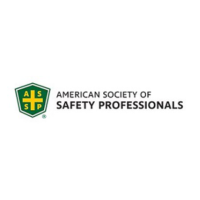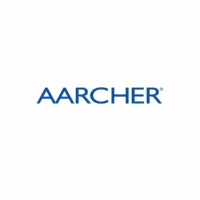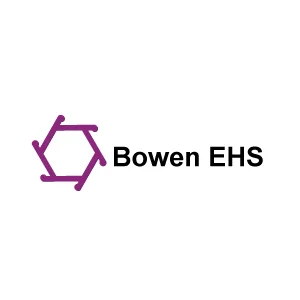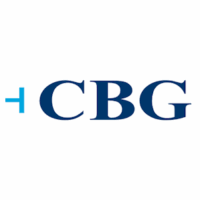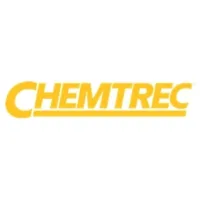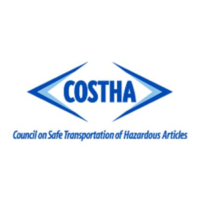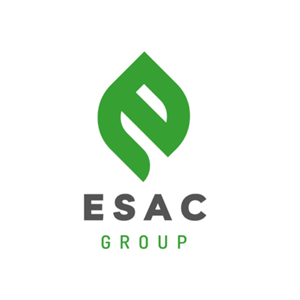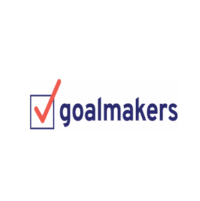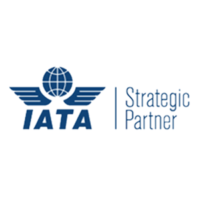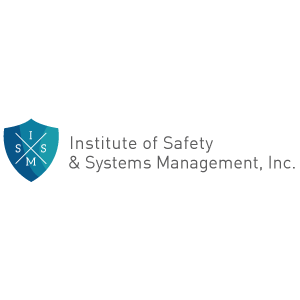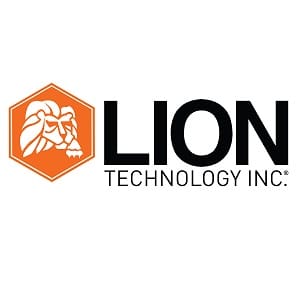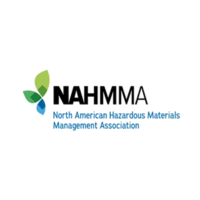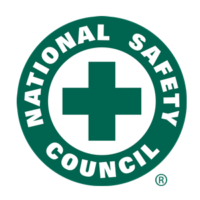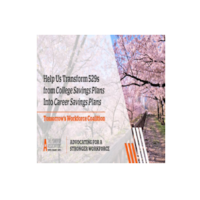IHMM Today is an online publication of the Institute of Hazardous Materials Management® (IHMM®).
Other than content specifically provided by IHMM, articles contained in IHMM Today are compiled from
independent sources and do not necessarily reflect the opinions of IHMM.
Associate Hazardous Materials Manager™ [AHMM™]
An Associate Hazardous Materials Manager™ (AHMM™) is specifically for [a] recent college graduates with little or no experience, [b] military personnel or those out of the military with no degree and less than 3 years of experience, or [c] other professionals such as first responders who have no degree or less than 3 years of experience. The AHMM is an early career professional with experience in handling hazardous materials in a wide variety of specialties, such as safety, environmental protection, compliance, or basic dangerous goods transportation. The AHMM professional focuses on technical knowledge and expertise in handling hazardous materials gained from some experience in the United States military from time in a military occupation specialty code [MOS] or Air Force Specialty Codes [AFSC], or formal education in undergraduate or graduate degree studies in applied science, environmental science, environmental engineering, chemistry, biology, physics, or geology.
Home | IHMM Credentials | Certificants | About IHMM | Event Calendar | Archive | Advertise with IHMM
The Value of IHMM Credentials
Below you will see the credential badges that are now in each CHMM, CHMP, CDGT, CDGP, AHMM, Student CHMM, CSHM, CSMP, CSSM, ASHM and Student ASHM certificant’s MYIHMM account. Every IHMM certificant may use these badges, linked as those below are to their IHMM credential page, for their email signatures, business cards, and other social media applications. You’re justifiably proud of the accomplishment of having earned your credential and you can show the rest of the world. Simply right-click on the badge of choice, save it to your computer, and then load it to wherever you want to use it, and please link that back to https://ihmm.org/.
Hazardous Materials / Dangerous Goods Transportation Credentials
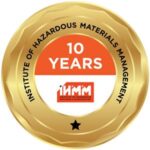
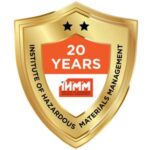
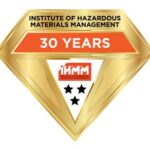
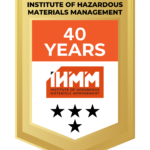
IHMM Certificant Recognition
Throughout our certificant’s MYIHMM accounts are placed 10-year, 20-year, 30-year, and 40-year badges signifying their longevity as an IHMM certified professional.
With a link from your credential badge to the IHMM website [see above] you can not only stand out as an IHMM-certified professional, you can also promote IHMM credentials to others. Right-click on the badge of choice, save as to your computer, then load it to whatever medium you choose.
IHMM has Distinguished Diplomates and Fellows of the Institute badges to the appropriate people in the MYIHMM database. These two badges are accompanied by lapel pins sent to each of those distinguished by holding these designations.
Follow IHMM on Social Media
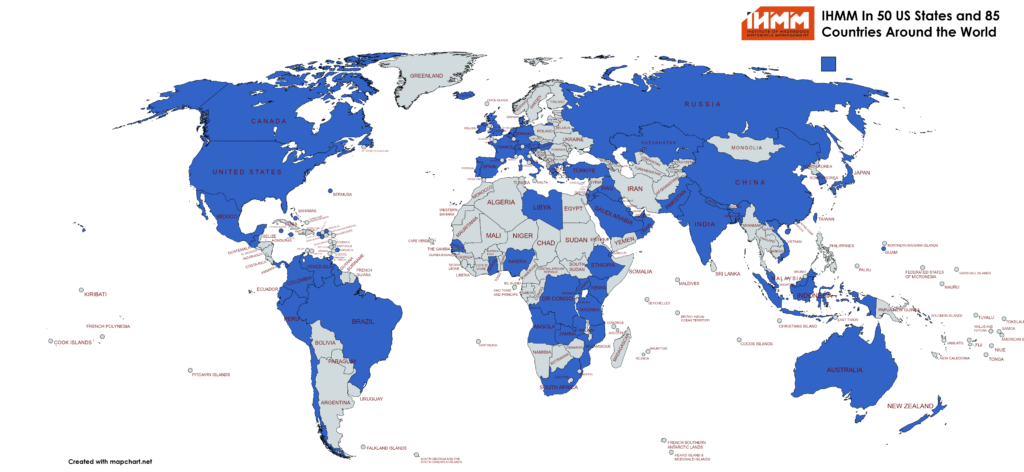
IHMM is in all 50 of the United States and in 85 countries around the World.
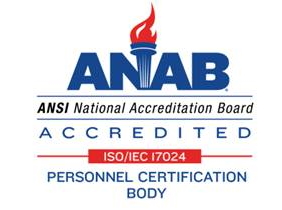
IHMM Credentials Accredited By

NEED HELP?

Need Help? On the IHMM website just click on the “NEED HELP?” button
and let us know what you need and the right person will get right back with you.
Need Help? On the IHMM website just click on the “NEED HELP?” button
and let us know what you need and the right person will get right back with you.
IHMM RECENT NEWS
HAZARDOUS MATERIALS/DANGEROUS GOODS
Maine Proposes Rule Regarding Products Containing Intentionally Added PFAS
EPA Requires Submission of Health and Safety Studies for 16 Chemicals Being Considered for Risk Evaluation under TSCA
EPA is hosting a webinar to present an overview of the Proposed 2026 MSGP – Jan 16 2025
EPA takes steps to require MSW incinerators to report toxic chemical emissions
EPA issues first underground injection permits for carbon sequestration in California
Big Leap Forward for Environmentally Friendly ‘E-Textiles’ Technology
New Method Turns E-Waste to Gold
Implementing Statutory Addition of Certain Per- and Polyfluoroalkyl Substances (PFAS) to Toxics Release Inventory (TRI) Beginning With Reporting Year 2025
Significant New Use Rules on Certain Chemical Substances (19-5.F)
Formaldehyde; Risk Evaluation Under the Toxic Substances Control Act (TSC); Notice of Availability
EPA Adds Nine Additional PFAS to the Toxics Release Inventory
EPA Finalizes Workplace Control Requirements for Carbon Tetrachloride
Washington Ecology Issues its New Industrial Stormwater General Permit, Effective January 1, 2025
Updates to New Chemicals Regulations under the Toxic Substances Control Act
EPA Requires Submission of Health and Safety Studies for 16 Chemicals Being Considered for Risk Evaluation under TSCA
California Prop 65’s Short-form Warnings Will No Longer Be Short – Summary of Amendments to Short-form Warnings under California Proposition 65 – Effective January 1, 2025 with Three-Year Grace Period
Hazardous Materials and Waste Management
Dangerous goods shipments under the spotlight
EHS/WORKPLACE SAFETY
Make Your Safety Training Effective
Understanding & Preventing Cold Stress
Construction leaders eye estate planning as tax changes loom
Key Bridge rebuild to begin this month
Why construction productivity growth is lagging — and what to do about it
Multifamily starts fall dramatically
Wearables at work can break the law if employers aren’t careful, EEOC warns
Construction fatalities hit highest number since 2011
Roofers at Highest Risk for Brain Injuries in Construction: Tips to Minimize Hazards
NFPA 70E 2024 Changes: What’s New?
In First-of-its-Kind Move, OSHA Settles With Amazon Over Hazardous Working Conditions
Tariffs could jump by $800B annually: PwC
How US construction left the world behind
Florida company cited over worker’s heat death as governor bans heat protection policies
5 often-overlooked wintertime hazards
2024’s top legal issues
ASSP Updates Standards on Safety Training and Hazardous Energy
NFPA Codes 99 and 101: Key Changes to Understand in Healthcare Safety
Federal vs. State Courts: Gender Protections, Discrimination in the Workplace
Written Safety Plans: Not Just a Paperwork Exercise
OSHA cites companies following worker deaths
California board says yes to permanent standard on silica exposure
Another round of OSHA’s most interesting cases
DOL Guidelines Call for Responsible AI Adoption to Ensure Safe Workplaces
Maine Contractor Cited for Fatal Trench Collapse After Ignoring Safety Warnings
Top 10 Largest Roofing-Related OSHA Penalties of 2024
Inside IHMM

400,000 Per Month
400,000 is the number of messages sent from IHMM each month to thousands of private and public sector entities to raise the visibility of IHMM, IHMM credentials, and IHMM credential holders.
Whether for Jason Kasten in Wisconsin who just earned his CSHM credential, Jerimiah Larson and Nicholas Cantu who just passed their CHMM exam, or Patrick McDowell, ST/CHMM who is our recent Certificant Spotlight, and the thousands in between in 50 states and 85 countries, we believe in promoting IHMM’s certificants and their achievements.
One day at a time, IHMM’s mission includes building understanding in 50 states and 85 countries around the world of the critically important role IHMM’s credentials and our credential holders play as IHMM sets standards of excellence for professional credentials to advance the global environmental, health, and safety communities of practice.
400,000 Per Month
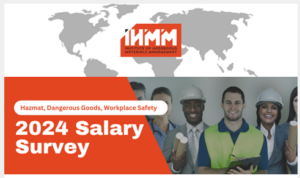
IHMM Releases 2024 Salary Survey Results
IHMM is pleased to release the 2024 survey of salaries underlying the hazardous materials/dangerous goods credentials salaries by job totle, as well as the 2024 survey of salaries underlying the workplace safety credentials salaries by job title. You may download these surveys as linked below.
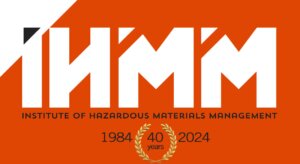
IHMM Enters Its 40th Year
On December 3, 1984 the Institute of Hazardous Materials Management was created with the Certified Hazardous Materials Manager® [CHMM®] credential. John H. Frick, Harold M. Gordon, John J. McCambridge, and Richard A. Young created what would become an Institute that offers 11 professional credentials across Hazardous Materials/Dangerous Goods and EHS Work Place Safety communities of practice in all 50 of the United States and 85 other countries.
IHMM thanks its hundreds of volunteer leaders, thousands of certificants and companies who support IHMM through strengthening its ability to extend its reach and allow us all to live up to why we exist our vision, and our mission…
Why We Exist
We believe there is only one Earth; our passion is to protect it.
Our Vision
IHMM credentials and competency standards are embraced worldwide
Our Mission
IHMM sets standards of excellence for professional credentials to advance the global environmental, health, and safety communities of practice.
IHMM Elects Officers for 2025
IHMM would not be where it is today without the energy, vision, and commitment of its hundreds of volunteer leaders. Congratulations to the new 2025 IHMM Executive Committee, with Melissa Hamer, CHMM as Chair, June Brock-Carroll, CHMP as Vice Chair, Jan Rosenberg, CSHM as Treasurer, and Morgan Hyson as Secretary.

Melissa A. Hamer, Esq. CHMM
Chair
Ms. Hamer is an attorney practicing environmental law in Indiana. She was elected as a Director in 2019. 2nd term expires 12/31/2027

June Brock-Carroll, CHMP
Vice Chair
Mrs. Brock-Carroll is the Research Safety Hazardous Materials Manager at Clemson University in South Carolina. She was elected as a Director in 2017. Second term expires 12/31/2025.

Jan G. Rosenberg, CSHM
Treasurer
Mr. Rosenberg is a consultant and former Deputy Administrator of the State of Nevada’s Division of Industrial Relations with a focus on OSHA enforcement and compliance. He came on the Board in 2019. Second term expires 12/31/2026.

W. Morgan Hyson.
Secretary
Morgan is the Public Member of the Board who was re-elected in 2024 for a 4-year term that ends 12/31/2028. Morgan is a former staff member at IHMM who now works at the State Department.
The Dr. John H Frick Memorial IHMM Scholarship Program – Accepting Applications in September, 2025
The Institute of Hazardous Materials Management is pleased to have created $32,000 in academic scholarships, divided equally between $16,000 for students enrolled in undergraduate or graduate education in approved schools and who are also Student CHMMs, and $16,000 for students enrolled in undergraduate or graduate education in approved schools and who are also Student ASHMs.
IHMM seeks to foster the growth and academic success of students whose courses of education, and participation in one of our Student certifications, will lead to those students becoming fully-certified IHMM credential holders later in their professional lives.
Go to > https://ihmm.org/scholarship/
2024 IHMM Dr. John H. Frick Memorial Scholarship Winners
IHMM is pleased to announce the winners of the 2024 Dr. John H. Frick Memorial Scholarships. The winners, below, exemplify the commitment to their future communities of practice and the pursuit of excellence that makes their early career IHMM credentials vibrant. We congratulate them all and wish them the best as they pursue their degrees and we look forward to their participation in IHMM’s credentials for decades to come.

Dylan Tripoli, Student CHMM
University of Maryland Global Campus
$5,500

Raymon Brison, ASHM
Columbia Southern University
$5,500

Joseph Nyakundi, Student ASHM
University of Cincinnati
$4,500

Mobu Olufemi, Student ASHM
University of Utah
$2,000

Weston Farley, Student ASHM
Utah State University
$2,000
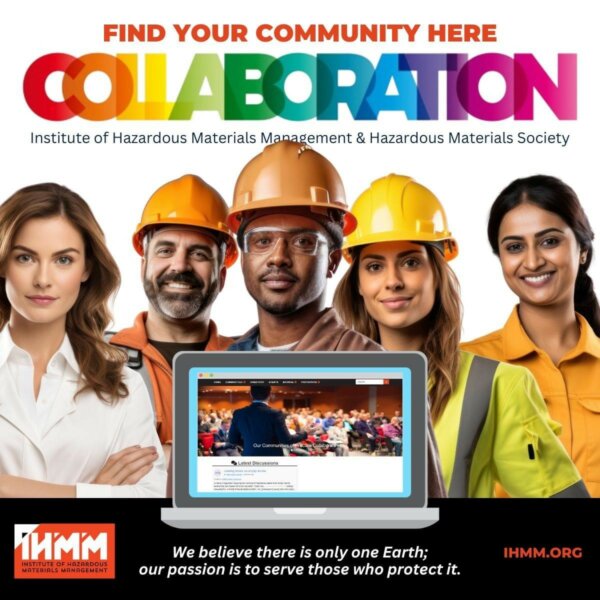
Creating a Collaborative Culture
1,521 different conversations are going on in the IHMM/HMS Collaboration platform this week.
Do you have a problem you need to solve and want the opinions of your colleagues? We created the COLLABORATION platform to enable our certificants to network, learn, and grow from one another.
This is where we collaborate with the best people in their fields, always willing to help one another lessen the stress of our jobs and where we strive as a team to make a difference of which we are proud.
You can collaborate here.
Access to COLLABORATION is through the same username/password you use to access your MYIHMM account. Are you having a problem? Contact Jimmy Nguyen at [email protected]
#1 – Recertification Video
#2 Recertification Video
IHMM Recertification Videos
Congratulations. After hard work and dedication, you earned your professional credential. Now, every 5 years, you will need to recertify your valuable credential. Over 5 years, you need to earn 200 certification maintenance points or CMPs. You receive 100 CMPs for the job you perform, and then need to earn a minimum of another 100 CMPs in a variety of ways, demonstrating your commitment to continuous improvement and remaining current with the demands of your profession and our communities of practice.
Considering everything you did to achieve certification, don’t let it go to waste by failing to recertify.
IHMM Code of Ethics
The IHMM Code of Ethics is essential as it serves as a navigational compass that guides us all in making decisions that align with shared values and ethical principles. It provides a framework for behavior that helps to maintain integrity, trust, and respect in professional and personal interactions. For professional certificants, adhering to the IHMM Code of Ethics is a certification requirement, ensuring that your actions meet industry standards and public expectations. In the business world, a Code of Ethics enhances our reputation, fosters a positive work environment, and promote accountability and continuous improvement in ethical conduct. Moreover, a Code of Ethics helps us navigate morally complex situations, ensuring that our actions are legally and safely grounded in our core values, such as honesty, accountability, and compassion. Ultimately, our Code of Ethics is about committing to a set of principles that not only guide one’s actions but also define one’s character and professional identity.
Everyone sees the IHMM Code of Ethics and signs an adherence statement on making application for one of our credentials. Every existing certificant sees the Code of Ethics again upon recertification and takes a short quiz on the IHMM Code of Ethics.
See the IHMM Code of Ethics video here:
IHMM CONFERENCES For 2025
IHMM attended and supported a number of conferences and trade shows throughout 2024. In 2024 IHMM participated in the Bay Area ASSP conference, AIHA Conference & Trade Show, Modern Day Marine Conference, ASSP Annual Conference, AHMP Conference, Environmental Navigator Conference, National Safety Council Conference, and FET.
Are there conferences you believe IHMM should attend in 2025 that are not named here? If so, let us know by sending an email to [email protected]
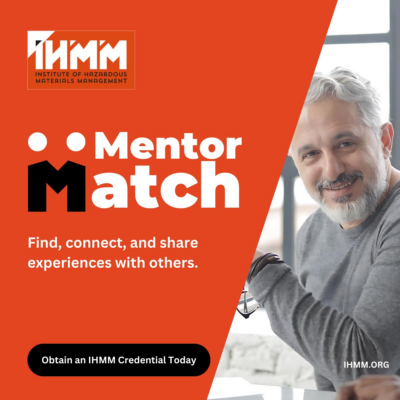
IHMM – 33 Mentors Available for You
IHMM Fellows Committee Chair Atanu Das, CHMM, is leading the effort within the IHMM Collaboration networking platform to engage 26 IHMM Fellows as Mentors and anyone seeking assistance as Mentees.
Given Fellows’ extraordinary experience, this is a unique opportunity for IHMM Fellows to help guide more recent certificants in their professional development activities. This article from ASAE magazine outlines how a mentoring program can become more successful – engagement!
IHMM’s Collaboration platform contains a “Mentor Match” module [see below at right] that allows mentors to signup designating the hours, number of mentees, subject areas, and length of time they wish to mentor – as well as enabling mentees signup requesting assistance in specified areas. The mentor match module does the rest by matching mentors and mentees.

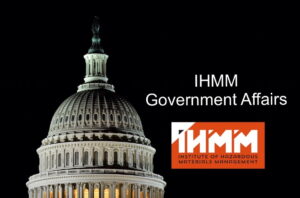
IHMM Organizing Broader Government Affairs Activities – Call for Volunteers
In strategic planning on August 17, 2023 IHMM created a strategic imperative to create a broader government affairs operation on behalf of, and with the assistance of, all of IHMM’s certificants.
- Federal Government – Regulatory
We need a group of people watching Federal regulatory developments to advise when taking action can be helpful and raise our visibility in the agencies. - Federal Government – Congress
We need a group of people watching legislation to advise us when taking action can be helpful and raise our visibility in Congress.
- State Governments – Regulatory
We need a group of people watching state regulatory developments to advise when taking action can be helpful and raise our visibility in the agencies. - State Governments – Legislatures
We need a group of people watching legislation to advise us when taking action can be helpful and raise our visibility in state legislatures.
If you want to make a difference in the recognition of your credentials and build on the successful record we have achieved thus far – we need you to volunteer. Learn more by visiting our Government Affairs Committee page, and get involved with government affairs. You can volunteer for one, two, three or all four of the segments of the committee’s work. That’s up to you!

IHMM Proposes Changes in Government Recognition of Credentials
- IHMM has filed comments on the OMB Inquiry concerning the EPA and DOL proposed regulatory measures concerning Methylene Chloride on December 13, 2024.
- IHMM Sent a letter to the U.S. Department of the Interior, National Park Service, concerning the uses of professionally credentialed persons performing work for the Park Service.
- IHMM Signs Letter Opposing Reductions in OSH Worker’s Pay – The IHMM Government Affairs Committee has agreed to sign a coalition letter opposing reductions in pay for IH and OSH employees. Here is the coalition letter we signed.
4. IHMM submitted comments on OSHA Advisory Committee on Construction Safety and Health (ACCSH): Notice of Meetings concerning OSHA-2024-0002-0007, and highlighted the creation of IHMM’s Certified Pandemic Preparedness Specialist [CPPS] credential.
5. State of Maine Department of Environmental Protection is proposing to update Chapter 851, Standards for Generators of Hazardous Waste. In the current regulation, work is required by a professional engineer. IHMM is proposing to include an environmental professional as defined by 40 CFR §312.10.
All IHMM Government Affairs Projects Are Here
Beltway Buzz – Ogletree Deakins
Biden-Era NLRB Wraps Up. With the 2021 appointments of David Prouty and Gwynne Wilcox, the Biden-era National Labor Relations Board (NLRB) in earnest began tilting the labor-management policy landscape in favor of organized labor. But this pro–big labor era at the Board will likely be coming to an end soon. December 16, 2024, was the last day of NLRB Chair Lauren McFerran’s term. The U.S. Senate’s 50–49 rejection of McFerran’s reconfirmation on December 11, 2024, leaves the Board with two Democrats—Gwynne Wilcox and David Prouty—and one Republican—Marvin Kaplan. It also presents President-elect Donald Trump with the opportunity to quickly gain a Republican majority on the Board in 2025. But change won’t happen immediately—it will take some time for nominees to get confirmed and cases to get reversed.
Board Limits Employers’ Control Over Their Own Operations. With Chair McFerran’s departure from the Board, the regulated community is seeing the predicted “flurry” of decisions that happens when members’ terms expire. Most recently, the Board issued a decision that will make it more challenging for unionized employers to make changes to their business operations. In this case, the Board held that collective bargaining agreements must contain a “clear and unmistakable” waiver of the union’s right to bargain over workplace changes. Thomas M. Stanek and Zachary V. Zagger have the details.
H-1B Changes Finalized. On December 18, 2024, U.S. Citizenship and Immigration Services (USCIS) published a rule, “Modernizing H-1B Requirements, Providing Flexibility in the F-1 Program, and Program Improvements Affecting Other Nonimmigrant Workers.” Brian D. Bumgardner and Marissa E. Cwik have the details on the changes made to the definition of “specialty occupation,” the codification of deference to prior approvals, expansion of the H-1B cap exemption, site visits, and more.
By finalizing the remaining aspects of the proposed rule (the first part, which focused primarily on H-1B registration, selection, and integrity, went into effect earlier this year), the Biden administration takes a step toward shoring up its high-skilled immigration policy preferences. Of course, the rule is clearly subject to review pursuant to the Congressional Review Act (CRA). The incoming Congress could vote to rescind the regulation and would only need a majority vote in the Senate to do so (though Republican majorities in both chambers of Congress are razor-thin). Of course, once the CRA is used to rescind a regulation, agencies are prohibited from issuing any new rule that is “substantially the same form” as the disapproved rule. In this case, if Republicans use the CRA to rescind this rule, it could prohibit the incoming Trump administration from adjusting the prevailing wages for H-1Bs, as they tried to do in the first administration.
OSHA Finalizes PPE Rule. On December 12, 2024, the Occupational Safety and Health Administration (OSHA) published a final rule, “Personal Protective Equipment in Construction.” Existing requirements only state that personal protective equipment (PPE) must be “of safe design and construction for the work to be performed.” The new regulations state that employers must ensure that PPE “is selected to ensure that it properly fits each affected employee.” OSHA pursued the rulemaking with smaller employees in mind, particularly women. The rule is scheduled to go into effect on January 13, 2025. John D. Surma and Savannah M. Selvaggio have the details.
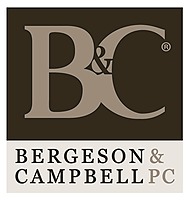
What to Expect from the New Administration: B&C Offers Webinar
“What to Expect When You Don’t Know What to Expect in Chemicals Policy and Regulation and on Capitol Hill in 2025,” January 14, 2025, 11:00 a.m. – 12:00 p.m. (EST).
REGISTER NOW
Lynn L. Bergeson, James V. Aidala, Mark J. Washko, and Richard E. Engler, Ph.D., will unpack the likely impacts of the new Administration on the regulated community, provide their seasoned outlook on how similar or different the Trump II Administration might be from the first term, and discuss what companies can do to respond to the opportunities and challenges presented.
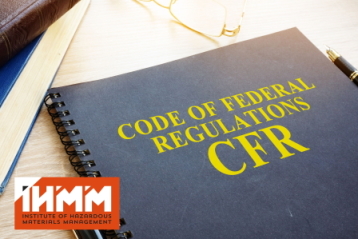
Regulatory Updates
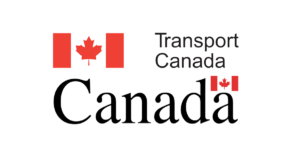
Transport Canada and the TDGR
The ministry published another in its series of regulatory guidance documents explaining its interpretation of the various sections of the TDGR. These guidance documents do not change the regulations, but instead offer users the ministry’s recommendations for applying them in practical ways. This new document deals with the classification of dangerous goods.
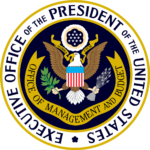
IHMM Filed Comments – Agency Information Collection Activities; Submission for OMB Review; Comment Request; Methylene Chloride Standard
Deadline: December 13, 2024
The agency published an ICR related to its Methylene Chloride standard. This chemical is hazardous but widely used in industry, so OSHA closely monitors safety standards. The regulation of methylene chloride, also known as dichloromethane (DCM), is primarily governed by the U.S. Environmental Protection Agency (EPA) under the Toxic Substances Control Act (TSCA).
- U.S. Environmental Protection Agency (EPA). (2024). A Guide to Complying with the 2024 Methylene Chloride Regulation Under the Toxic Substances Control Act (TSCA).
- U.S. Environmental Protection Agency (EPA). (2024). Risk Management for Methylene Chloride.
- U.S. Environmental Protection Agency (EPA). (2024). Fact Sheet: Regulation of Methylene Chloride under TSCA.
These regulations aim to protect public health and the environment by reducing exposure to this hazardous chemical.
IHMM Comments Filed 12-13-2024
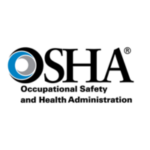
IHMM Drafts Comments – OSHA – Proposed Rule to Protect Indoor and Outdoor Workers from Extreme Heat
Deadline: January 14, 2025
The Occupational Safety and Health Administration (OSHA) has released a proposed rule that would protect approximately 36 million workers in indoor and outdoor work settings from extreme heat. The proposed rule would require employers to develop an injury and illness prevention plan to control heat hazards in workplaces affected by excessive heat. Among other things, the plan would require employers to evaluate heat risks and — when heat increases risks to workers — implement requirements for drinking water, rest breaks and control of indoor heat. It would also require a plan to protect new or returning workers unaccustomed to working in high heat conditions.
IHMM has initiated the process of collecting comments from its Government Affairs Committee concerning this proposed regulation and intends on submitting comments on or before January 10, 2025. Any IHMM certificant who wishes to submit comments to IHMM is encouraged to do so by sending an email to Gene Guilford at [email protected]
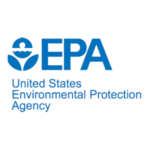
New EPA Regulatory Actions
Methane Charges
The Environmental Protection Agency (EPA) is promulgating a regulation to facilitate compliance with the requirements of the Waste Emissions Charge in the Clean Air Act’s (CAA) Methane Emissions Reduction Program (MERP). Enacted as part of the Inflation Reduction Act (IRA), this program requires the EPA to impose and collect an annual charge on methane emissions that exceed waste emissions thresholds specified by Congress.
DATES:
This final rule is effective January 17, 2025.
ADDRESSES:
The EPA has established a docket for this action under Docket ID No. EPA-HQ-OAR-2023-0434. All documents in the docket are listed in the https://www.regulations.gov index.
Toxic Substances Control Act: decaBDE and PIP (3:1) Exposure
The Environmental Protection Agency (EPA or Agency) is finalizing revisions to the regulations for decabromodiphenyl ether (decaBDE) and phenol, isopropylated phosphate (3:1) (PIP (3:1)), two of the five persistent, bioaccumulative, and toxic (PBT) chemicals addressed in final rules issued under the Toxic Substances Control Act (TSCA) in January 2021. After receiving additional comments, the Agency has determined that revisions to the decaBDE and PIP (3:1) regulations are necessary to address implementation issues and to further reduce the potential for exposures to decaBDE and PIP (3:1) for humans and the environment to the extent practicable.
DATES:
This rule is effective on January 21, 2025.
ADDRESSES:
The docket for this action, identified by docket identification (ID) number EPA-HQ-OPPT-2023-0376, is available online at https://www.regulations.gov. Additional instructions on visiting the docket, along with more information about dockets generally, is available at https://www.epa.gov/dockets.
FOR FURTHER INFORMATION CONTACT:
For general information: The TSCA Hotline, ABVI-Goodwill, 422 South Clinton Ave., Rochester, NY 14620; telephone number: (202) 554-1404; email address: [email protected].
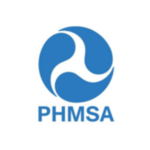
Lithium Battery Guide For Shippers
This compliance resource was prepared to assist a shipper to safely package lithium cells and batteries for transport by all modes of transportation according to the latest regulatory requirements. This guide provides scenario-based situations that outline the applicable requirements that a shipper must follow to ship packages of lithium cells and batteries in various configurations. Each distinct shipping guide in this document refers to the regulatory requirements for a specific lithium cell/battery type, configuration, and size. In this way, a shipper will easily find the applicable provisions that they must follow depending on the scenario they encounter as a shipper.
Please note that these shipping guides are based on the Hazardous Materials Regulations (HMR; 49 CFR Parts 171-180) and can be used as a compliance tool to help outline applicable scenario-based regulatory requirements; this document is not a substitute for the HMR. While every effort has been made to provide a simplified compliance resource consistent with the HMR, if there is any instance in which this document is inconsistent with the HMR, then the HMR requirements supersede this guide. The regulations themselves are the final authority for proper shipping procedures.
Download the PHMSA Lithium Battery Guide for Shippers
______
Additional Compliance Dates
DOT:
Compliance date: April 10, 2025
- UN38.3 Test Summary Report – remove the requirement of a signature; however, the name and title of a responsible person is required
- Remove the lithium battery test summary document requirement for button cell batteries installed in equipment.
- Require lithium-ion batteries be marked on the outer casing with the Watt-hour (Wh) rating. This is consistent with the provisions for smaller lithium ion batteries.
- Clarify the packaging requirements for lithium batteries packed with equipment – PGII packaging.
- Include the limitation for the number of spare batteries in the package when transported by air.
- The number of cells or batteries in each package is limited to the minimum number required to power the piece of equipment, plus two spare sets. A set of cells or batteries is the number of individual cells or batteries that are required to power each piece of equipment
- Multiple pieces of equipment in an outer package must be packed to prevent contact with other equipment.
- Remove the telephone number from the lithium battery mark with a transition period until December 31, 2026 (harmonized with the international regulations)
- Remove the exception to small lithium cells and batteries alone by air transport (c)(4)(i), (ii), (iii), (v), (viii). \
- Require packages for small lithium cells and batteries be capable of a 3m stack test for 24 hours.
IATA
- Changes Effective 1 January 2025 for lithium-ion batteries packed with equipment, lithium-ion batteries contained in equipment, and vehicles powered by lithium ion batteries
- It will be recommended that when offered for air transport:
- lithium ion batteries packed with equipment,
- lithium ion batteries contained in equipment and
- vehicles powered by lithium ion batteries
Should have the batteries at a state of charge not exceeding 30% of their rated capacity.
- Vehicles powered by lithium ion batteries
- New entries:
§ UN3556 – vehicles powered by lithium ion batteries
§ UN3557 – vehicles powered by lithium metal batteries when the battery is rechargeable
§ UN3558 – vehicles powered by sodium ion batteries
o There will be a transitional period until 31 March 2025, during which time these vehicles may still be shipped as UN 3171, Battery-powered vehicle.
o 1 January – 31 December 2025 Vehicles should be offered for transport with:
§ the battery(ies) at a state of charge not exceeding 30% of their rated capacity; or
§ an indicated battery capacity not exceeding 25%.
–Thank you to Greg Bordner for publishing this list

PHMSA and NEPA
Deadline: January 9, 2025
The agency is proposing to establish new categorical exclusions in accordance with the National Environmental Policy Act’s implementing procedures. Categorical exclusions are categories of actions that an agency has determined normally do not have a significant effect on the human environment, individually or in the aggregate. Categorical exclusions are a form of review that agencies use to comply with the National Environmental Policy Act for proposed actions that normally have no or minimal environmental effects. PHMSA requests the views of the public on its proposal to establish these CEs and agency National Environmental Policy Act procedures. Submit written comments on or before January 9, 2025.

Reconsideration of the Dust-Lead Hazard Standards and Dust-Lead Post-Abatement Clearance Levels
Deadline: January 13, 2025
As part of EPA’s high-priority efforts to reduce childhood lead exposure, and in accordance with a U.S. Court of Appeals for the Ninth Circuit 2021 opinion, EPA is finalizing its proposal to lower the dust-lead hazard standards to any reportable level as analyzed by a laboratory recognized by EPA’s National Lead Laboratory Accreditation Program (NLLAP). EPA’s lead-based paint (LBP) regulations do not compel property owners or occupants to evaluate their property for LBP hazards or to take control actions, but if a LBP activity such as an abatement is performed, then EPA’s regulations set requirements for doing so. EPA is also finalizing changes to lower the post-abatement dust-lead clearance levels to 5 micrograms per square foot (µg/ft2 ), 40 µg/ft2 , and 100 µg/ft2 for floors, window sills and troughs respectively, the current levels in New York City. Due to feedback from public comments, EPA is also finalizing changes to the nomenclature to adopt the terms dust-lead reportable levels (DLRL) and dust-lead action levels (DLAL). Given the decoupling of the action levels from the reportable levels, EPA is finalizing revisions to the definition of abatement so that the recommendation for action based on dust-lead applies when dust-lead loadings are at or above the action levels, rather than the hazard standards, as has been the case historically. The dust-lead hazard standards will be described as DLRL moving forward ( i.e., after publication of this final rule) and the dust-lead clearance levels will be described as DLAL. Additionally, EPA is finalizing several other amendments, including revising the definition of target housing to conform with the statute.
DATES:
This final rule is effective January 13, 2025. The incorporation by reference of certain material listed in this rule is approved by the Director of the Federal Register as of January 13, 2025.
Federal Register here

PHMSA NPRM on HMR
Deadline: January 27, 2025
The agency published a new proposed rule (NPRM) that if adopted will modify certain provisions of the HMR related particularly to modal-specific requirements. The following are, according to PHMSA, some of the more important topics that feature proposed revisions:
The PHMSA Hazardous Materials Regulations (HMR) rulemaking aims to enhance the safe transportation of hazardous materials by revising modal-specific requirements. Key proposed changes include:
Rail Transportation:
- Adopting amendments from the Railroad Safety Advisory Committee (RSAC) to improve safety and clarity.
- Replacing AAR approval of tank car designs and Quality Assurance Programs (QAPs) with a PHMSA registration program for Design Certifying Engineers (DCEs) and tank car facilities. This aims to increase efficiency and oversight.
- Updating incorporated by reference (IBR) materials, including the AAR Manual of Standards.
- Clarifying and streamlining requirements for tank car unloading, marking, and inspections.
Highway Transportation:
- Implementing improvements based on industry input and safety analysis.
- Clarifying marking requirements for cargo tanks carrying petroleum distillate fuels.
- Updating definitions and clarifying requirements for cargo tank inspections and maintenance.
Vessel Transportation:
- Harmonizing regulations with international standards and making editorial revisions for clarity.
- Improving requirements for stowage, handling, and segregation of hazardous materials.
Multi-modal Changes:
- Clarifying security plan requirements and hazardous materials shipping paper information requirements.
- Updating various definitions and editorial revisions across different transportation modes.
The rulemaking includes regulatory analyses addressing statutory authority, federalism, regulatory flexibility, environmental impacts, and paperwork reduction. PHMSA anticipates the changes will maintain or enhance safety while increasing clarity and reducing compliance burdens. Specific cost savings are estimated at approximately $97.3 million annually.
Comments will be due no later than January 27th, 2025. See the details of this NPRM and find out how to comment here.
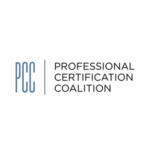
Professional Certification Coalition
While federal legislative action has been nearly non-existent throughout the fall given that Congress has been in recess for the election campaign, planning is well underway for legislative activity in 2025, regardless of which political party controls the lever of power. In particular, congressional Republicans have been hard at work preparing for action on legislation to revise the tax code in 2025, in part due to the expiration of tax cuts implemented in 2017 (former President Trump’s Tax Cuts and Jobs Act). Earlier this month, the PCC – complementing a similar communication from PCC Steering Committee member ASAE – composed and transmitted a letter supporting our Freedom to Invest in Tomorrow’s Workforce Act to the House Ways & Means Committee “Republican Tax Teams” who are taking the lead in determining what legislation will comprise the tax-reform legislation package. Please find this letter attached. To be sure, key Members and staff are already well aware of the PCC’s support for this legislation via our frequent outreach to them, but this puts the PCC officially “on the record” that we are pushing for inclusion of the bill in the tax package for next year. At the same time, we are actively strategizing regarding the best ways to promote our legislation, including determining who could serve as co-leads on a newly introduced version of the bill in 2025, since our lead House Democrat, Rep. Abigail Spanberger (D-VA), and lead Senate Republican, Sen. Mike Braun (R-IN), are both retiring from office at the end of the year to prepare campaigns for governor in their respective states.
IHMM is a member of the PCC. The PCC monitors state and federal legislative and regulatory activity affecting professional certification on an ongoing basis.
Expect new legislation being tracked in 2025 when new Legislatures convene:

Tomorrow’s Workforce Coalition – Senate Action On IHMM-Supported Legislation
The Tomorrow’s Workforce Coalition advocates for beneficial workforce development policy to strengthen the economy now and in the future.
For those of you who were unable to join us for the General Election Recap Webinar that took place on November 13th, please find the webinar recording below to watch at your convenience:
The Coalition supports the bipartisan, bicameral Freedom to Invest in Tomorrow’s Workforce Act (S. 722 / H.R. 1477), which would expand qualified expenses under 529 savings plans to include postsecondary training and credentialing, such as licenses and nongovernmental certifications; it would provide valuable tax-advantaged resources to more workers pursuing career growth, mid-career changes or alternative career pathways.
The Coalition is preparing for the new Congress, which is sworn in on January 3, 2025, and the new President.
S. 722 / H.R. 1477 / Coalition Roster
Senate Leaders Finalize Committee Assignments for the 119th Congress
Senate Republican Leader John Thune (R-SD) and Democratic Leader Chuck Schumer (D-NY) have announced committee assignments for the new Congress, including appointments for newly elected members.
The full list of Republican appointments is here. The full list of Democrat appointments is here.
Important Stories for IHMM Certificants
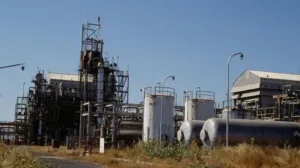
Tonnes of toxic waste removed decades after gas leak that killed thousands
BBC
Authorities in India have removed hundreds of tonnes of toxic waste from a chemical factory that witnessed one of the world’s deadliest gas leaks 40 years ago.
Thousands of people died in the central city of Bhopal in December 1984 after breathing a poisonous gas leaked from the factory.
On Wednesday, around 337 tonnes of toxic waste was taken from the Union Carbide plant to an incinerator facility around 230km (143 miles) away after a court last month set a four-week deadline for it to be disposed of.
Officials say it will take between three and nine months to treat and destroy the waste but activists have raised concerns about potential damage to people’s health at the new location.

ADR 2025 – Agreement concerning the International Carriage of Dangerous Goods by Road
ADR applicable as from 1 January 2025
View and download the full text of the ADR applicable as from 1 January 2025 as published in English, French and Russian (languages of the Economic Commission for Europe). For other linguistic versions prepared by ADR contracting parties, see ADR linguistic versions.
Requests to reproduce excerpts or to photocopy should be addressed to the Copyright Clearance Center at copyright.com.
Printed versions and electronic editable versions are available for sale at the United Nations Publications section. Search for ADR 2025 on https://shop.un.org.

2025 Forecast for U.S. Federal and International Chemical Regulatory Policy
Bergeson & Campbell, P.C. (B&C®), its global consulting affiliate The Acta Group (Acta®), and consortia management affiliate B&C® Consortia Management, L.L.C. (BCCM) are pleased to share with you our 2025 Forecast for U.S. Federal and International Chemical Regulatory Policy.
We offer you our best wishes for good health, happiness, and success in what will be a very busy New Year.

PCE and TCE under the Toxic Substances Control Act
EPA issued two final rules to address the unreasonable risk of injury to health presented by perchloroethylene (PCE) and trichloroethylene (TCE) under the Toxic Substances Control Act (TSCA), respectively. The rules will apply TSCA requirements to the chemical substances including preventing consumer access to the chemicals, restricting the industrial and commercial use, and providing time-limited exemptions for critical or essential uses. Effective January 16 for TCE and January 17 for PCE.

EPA Proposes Stormwater General Permits
Proposed 2026 Multi-Sector General Permit Out for Public Comment
EPA is seeking public comment on a proposed 2026 National Pollutant Discharge Elimination System (NPDES) Multi-Sector General Permit (MSGP) for stormwater discharges from industrial activity. This proposed permit would replace the 2021 MSGP upon finalization. This proposed permit would cover stormwater discharges from industrial facilities in areas where EPA is the NPDES permitting authority.
EPA will take comments on the proposal during a 60-day comment period, which ends February 11, 2025. Comments must be received on or before February 11, 2025.
Proposed Modification to 2022 Construction General Permit (CGP)
EPA proposed a narrow modification to its 2022 Construction General Permit (CGP) to expand the list of areas eligible for coverage to include all Lands of Exclusive Federal Jurisdiction in the U.S. This modification is necessary because EPA is the permitting authority in Lands of Exclusive Federal Jurisdiction, and when the 2022 CGP was issued on February 17, 2022, the permit did not specifically provide eligibility for all of these areas.
EPA is seeking comment only on the proposed permit revisions and the accompanying fact sheet. Comments on the proposed modification are due by January 13, 2025.
For any questions related to this announcement, please contact [email protected] for MSGP-related questions and [email protected] for CGP-related questions.

EPA Issues Final 2026 NPDES Pesticide General Permit (PGP)
The U.S. Environmental Protection Agency (EPA) is issuing the 2026 National Pollutant Discharge Elimination System (NPDES) Pesticide General Permit (PGP) for discharges of pesticides to waters of the United States. Similar to the previously issued PGPs, the 2026 PGP regulates point source discharges of biological pesticides and chemical pesticides that leave a residue. The permit covers mosquito and other flying insect pest control; weed and algae pest control; animal pest control; and forest canopy pest control. EPA is issuing this permit in all areas where EPA is the NPDES permitting authority. Pursuant to a settlement agreement, EPA signed the 2026 PGP on December 10, 2024, with an effective date of October 31, 2026.
- The Federal Register Notice, final permit documents, and all supporting information can be found on the docket at: https://www.regulations.gov/docket/EPA-HQ-OW-2023-0268.
- Information on the settlement agreement within the permit docket: https://www.regulations.gov/document/EPA-HQ-OW-2023-0268-0013.
- Information is also available on EPA’s Pesticide Permitting website: https://www.epa.gov/npdes/pesticide-permitting-2026-pesticide-general-permit.
For any questions related to this announcement, please contact [email protected].

Proposed Methods Update Rule 22 Signed by the EPA Administrator
On December 6, 2024, EPA released a proposed rule, Clean Water Act Methods Update Rule 22 for the Analysis of Contaminants in Effluent, which would add or revise analytical methods, or test procedures, for measuring pollutants (also called parameters) in wastewater. Specifically, EPA is proposing to add new agency test methods for per- and polyfluoroalkyl substances (PFAS) and polychlorinated biphenyl (PCB) chemicals and add methods previously published by voluntary consensus standard bodies such as ASTM International, or other vendors. When finalized, industries, states, and municipalities would use these methods for reporting under the EPA’s National Pollutant Discharge Elimination System permit program.
EPA’s proposed rule would also withdraw seven PCB mixtures (Aroclor) parameters. In addition, EPA is proposing to simplify the sampling requirements for two volatile organic compounds and make a series of minor corrections to existing tables of approved methods. This proposed rule does not mandate when a pollutant must be monitored nor whether to establish a discharge limit for a parameter. The agency will accept public comments on the proposed rule for 30 days upon its publication in the Federal Register. For more information on this proposed rule, visit the EPA’s Clean Water Act Methods website.
For any questions related to this announcement, please contact [email protected]

Per- and Polyfluoroalkyl Substances (PFAS) News and Information
The attorneys, scientists, regulatory specialists, and business consultants of Bergeson & Campbell, P.C. (B&C®) and our consulting affiliate The Acta Group (Acta®) relentlessly participate in and track developments regarding the global regulatory approach to PFAS. We offer this constantly updated library of PFAS resources to help those in the chemical and chemical products industry understand what they need to know and what it means to their business.
EPA and Other Agency PFAS links:
- Recording, transcripts, and slides from EPA webinar “TSCA Section 8(a)(7) Rule: Reporting and Recordkeeping Requirements for PFAS” held January 25, 2024
- EPA PFAS Resource Page
- EPA List of PFAS for TSCA Section 8(a)(7) Rule
- PFAS Strategic Roadmap: EPA’s Commitments to Action 2021-2024
- EPA PFAS Strategic Roadmap: Research Tools and Resources Webinar Archive
- EPA PFAS Resources, Data and Tools
- EPA PFAS Analytic Tools
- EPA Press Releases Related to PFAS
- European Chemicals Agency (ECHA) PFAS Resource Page
- OECD Portal on Per- and Polyfluoroalkyl Substances (PFAS)
- Minnesota Pollution Control Agency PFAS ban

1/16/25 – Emerging Trends: Securing Extracurricular School Events
Safer Schools, in support of the Bureau of Justice Assistance’s Student, Teachers, and Officers Preventing (STOP) School Violence Program, is hosting a Knowledge College webinar titled “Emerging Trends: Securing Extracurricular School Events”.
This webinar will focus on strategies to enhance collaboration between law enforcement officers, school staff, and other stakeholders to prepare safety plans designed to enhance security, operationalize these plans, and conduct effective post-event debriefings that inform future operations. This virtual event will be led by a panel of law enforcement and school safety professionals that will share their insights on securing these extracurricular events. Participants will have the opportunity to engage with the panelists in a question-and-answer session.
______
Evidence-Based Guide: Suicide Prevention Strategies for Underserved Youth
SAMHSA’s new Evidence-Based Guide: Suicide Prevention Strategies for Underserved Youth offers tailored strategies to support at-risk groups and prevent youth suicides. This guide addresses barriers to accessing services, provides insights into effective prevention programs, and showcases initiatives making a difference in underserved communities. Designed to help schools, organizations, and communities, it’s a valuable resource for implementing and evaluating impactful suicide prevention strategies.
______
“Emerging Threats in K-12 Schools.”
Thank you for joining our recent webinar, “Emerging Threats in K-12 Schools.” The conversation was rich with insights on the evolving safety challenges schools face, including the impact of social media, staffing shortages, and the importance of trust and collaboration.
If you missed it—or want to revisit key takeaways—the webinar replay is now available.
In the webinar, we covered important topics including:
- Key considerations for crowd management
- The role of technology in improving event safety
- How to build a culture of security in school communities
______
STOP Grantees – Register Now!
STOP Grantees, join us for the STOP TTA Winter Quarterly Meetings, where we will review key trends from our needs assessment, followed by interactive breakout sessions for collaboration with other grantees. You will also get an exclusive preview of the upcoming Community of Practice platform for continued networking and idea-sharing. Don’t miss this opportunity to share your ideas, exchange knowledge, and contribute to the ongoing conversation about school safety!
- East Region: January 7, 2025 from 1:00 – 2:00 PM ET
- Midwest Region: January 8, 2025 from 12:00 – 1:00 PM ET
- West Region: January 13, 2025 from 3:00 – 4:00 PM ET
- South Region: January 14, 2025 from 12:00 – 1:00 PM ET
Register Now
______
School Resource Officer Video Series
School Resource Officers (SROs) play a key role in student safety, serving as advocates, educators, and protectors. This video series provides SROs with practical strategies to connect with students, understand their perspectives, and break down communication barriers to foster a positive presence in schools. Produced in partnership with Katherine Schweit, JD, at Schweit Consulting and Rocket Media Group, the series includes six short videos, each accompanied by an informational poster to reinforce key takeaways. Explore the videos and posters to strengthen your approach to building trust and ensuring a safe, supportive school environment.
Watch Now
_______
Empowering Education Leaders: A Toolkit for Safe, Ethical, and Equitable AI Integration
The U.S. Department of Education, Office of Educational Technology’s new Empowering Education Leaders Toolkit helps school leaders safely and equitably integrate AI into education. It provides steps for addressing issues like deepfakes, AI-generated school threats, and cyberbullying. The toolkit also offers guidance on protecting student privacy and data, ethical AI use, and presents an overview of federal laws and considerations. These are essential to anchoring and ensuring the use of AI in a safe, secure, and non-discriminatory manner. Explore the toolkit to learn about key considerations for AI in schools.
Learn More Here
______
Creating a Culture of Support: Enhancing Staff Resilience in Emergency Situations
Available Now as an On-Demand Webinar
Emergency drills can be stressful for school staff, but integrating mental health support and breaking down safety silos can enhance resilience.
In this on-demand webinar, presenters from the Colorado School of Public Health share strategies for improving emergency drill systems through tailored training, staff feedback, and local resource identification. Participants will learn to customize training for their districts, facilitate effective feedback sessions, and implement changes based on staff input.
Watch Now Here
________
- 1/8/25 – Supporting Children of Incarcerated Parents: Addressing School-Based Bias and Stigma
Hosted by The Council of State Governments (CSG) Justice Center - 1/15/25 – Enhancing School Safety Using Behavioral Threat Assessment
Hosted by the Department of Homeland Security - 1/15/25 – FERPA 101 and Data Security Best Practices
Hosted by the U.S. Department of Education - 1/22/25 – FERPA 201 and Transparency
Hosted by the U.S. Department of Education - 1/29/25 – Incident Response and Vetting Educational Technology
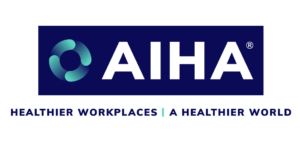
Investigating Impulse Noise
Although noise is present in almost every workplace, preventing hearing loss remains a challenge for occupational and environmental health and safety professionals. CDC estimates, based on data from 2014, that 12 percent of U.S. workers have hearing difficulties. One in four of these workers can attribute their hearing loss to occupational noise exposures. Workers’ risk of hearing loss increases in environments with complex noise, that is, when sharp, sudden impulse noise is added to the Gaussian noise of the background. However, impulse noise, also known as impact noise, is still not fully understood within the OEHS field. Many monitoring devices on the market are incapable of accurately measuring the phenomenon.
Read more here.

- Substances containing benzene dominate exports and imports of hazardous chemicals
- ECHA raises environmental concerns over certain aromatic brominated flame retardants
- Member States plan to evaluate 28 substances in 2025-2027
- Consultation on reporting requirements under the REACH restriction on microplastics
- Screening report published for 4-OPnEO and 4-NPnEO
- New substance evaluation conclusions published
- Highlights from December Member State Committee meeting
- Serious cross-border threats to health: tasks for ECHA
- Deepening cooperation with contract research organisations
- Assessment of regulatory needs reports published
- Consultations on harmonised classification and labelling
- Nanopinion: Ensuring safe and sustainable material innovation through advanced materials
IHMM Credential Recognition
The highest priority of IHMM’s Government Affairs Committee is the recognition of IHMM’s credentials by government. We have made substantial progress in the two years we have undertaken this endeavor, as outlined in detail here > https://ihmm.org/credential-recognition/
In this project we have 45-in-5, increasing the number of states that recognize IHMM credentials.
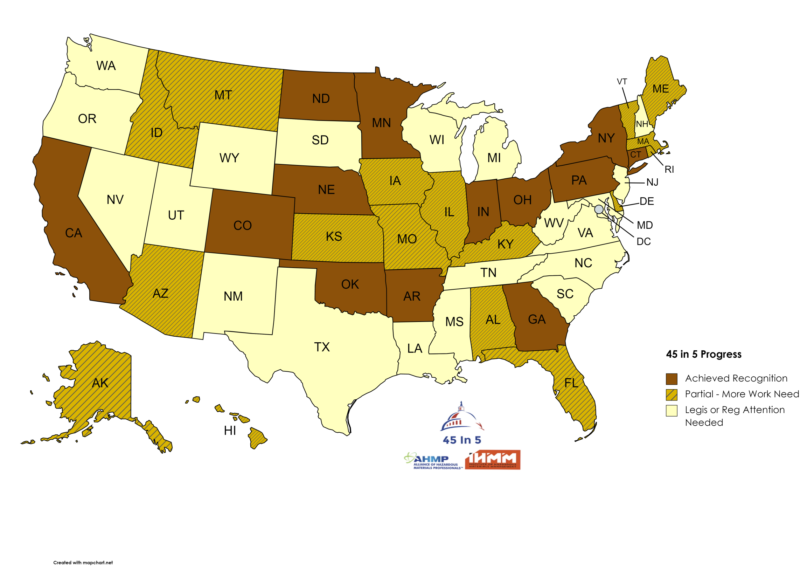
- We have already succeeded in 13 states – New York, Connecticut, Pennsylvania, Indiana, California, Colorado, Nebraska, Minnesota, Arkansas, Oklahoma. Ohio, North Dakota, and Georgia. [Red states in the map above]. These are states where IHMM credentials are cited or 40 CFR 312.10 is cited by reference.
- We have partially succeeded in another 16 states – Alaska, Hawaii, Idaho, Montana, Arizona, Kansas, Iowa, Missouri, Illinois, Kentucky, Florida, Delaware, Rhode Island, Massachusetts, Vermont, and Maine. [Orange/Black Stripe states in the map above] These are states where the requirements of an “environmental professional” or QEP are cited that coincide with an IHMM credential so that relatively little work would need to be done to clarify the desired outcome.
- We have 21 states where no reference to an IHMM credential is made in either statute or regulation, nor is there anything defined in the area of an environmental professional. These states will require legislation or regulatory work. [Yellow states in the map above].
in January 2022 Gene Guilford released the 40 CFR § 312.10 EPA regulation that states a private certification that meets or exceeds the requirements of the regulation is an Environmental Professional under the regulation. Here is the crosswalk between the 40 CFR § 312.10 EPA regulation and the Certified Hazardous Materials Manager [CHMM] blueprint. The CHMM meets or exceeds the requirements of an Environmental Professional.
Here’s what we ask each volunteer to do:
- Watch legislative and regulatory developments in your state that provide an opportunity for us to create amendments or other interventions
- Be willing to speak with regulators and legislators in your area about the recognition efforts we craft together
Retiring? IHMM Invites You to Become an Emeritus
You may have decided, after a long and successful career, to retire from active daily duty. Congratulations. That doesn’t mean you have to completely disengage from your profession. IHMM is pleased to offer Emeritus status to all certificants who will no longer be actively engaged in their communities of practice but who still want to stay in touch. Please let us know when you’re approaching that decision and we will assist you in the credential transition.
Please contact Jimmy Nguyen at [email protected] and he’ll be happy to help you.
News from IHMM Affiliates
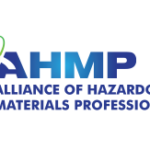
Alliance of Hazardous Materials Professionals
IHMM is affiliated with AHMP and is pleased to bring this important information to all of our certificants.
AHMP News
- Save the date for the 2025 EHS HazMat Summit which will be held in Louisville, KY, on September 8-11, 2025
- Call for AbstractsAHMP is now accepting abstracts for the 2025 EHS HAZMAT Summit to be held in September in Louisville, Kentucky. Submitting an abstract is a great way to share your knowledge and experience with colleagues, allowing you to showcase technical solutions, regulatory expertise, project successes, or case studies to help educate the conference attendees. Another benefit is that you can also earn valuable certification maintenance points for attending and presenting. To learn more and submit your abstract(s) visit https://www.ahmpnet.org/call-for-abstracts
- Award NominationsThe AHMP Awards program recognizes and honors individuals, chapters, and organizations for outstanding contributions in education, training, research, organizational development, operations, and performance that further AHMP’s Strategic Plan. There are four Professional Member awards, three Chapter awards, and two AHMP “Friend” awards. Nominations are being accepted now through April 30th. Visit https://www.ahmpnet.org/awards-program to learn more and submit a nomination.
AHMP Webinars

National Safety Council
IHMM is a member of the National Safety Council and is pleased to bring this important information to all of our certificants.
NSC News
- President Joe Biden designates national monument for Frances Perkins
- Researchers to explore strategies to improve construction worker safety
- Rep. Tim Walberg new chair of House Education and the Workforce Committee
- Australian agency releases case studies on managing psychological risks
- For older workers, volunteerism may slow the aging process
- ‘Unfavorable working conditions’ pave the way to trucker MSDs: study
NSC Webinars
- Jan 9 –OSHA’s HazCom Final Rule: What You Need to Know
- Jan 16 – Navigating OSHA Recordkeeping: Expert Insights for Accurate Reporting and Compliance
- Jan 30 – Simplifying OSHA Rooftop Fall Protection Requirements
- Feb 6 – How AI is Shaping the Future of Occupational Health and Safety
- Feb 13 – How to Engage the Front Lines in Safety

American Society of Safety Professionals
IHMM is a member of the American Society of Safety Professionals and is pleased to bring this important information to all of our certificants.
ASSP News
- Feb 13-Mar 13 – Advanced Safety Management Methods
- Feb 13 – Mar 13 – Influential Leadership Skills
- Feb 27 – Mar 27 – Risk Assessment and Management for Safety Professionals
- Feb 27 – Mar 27 – Corporate Safety Management(25FEB27)
- Feb 27 – Mar 27 – Prevention through Design
- Feb 27 – Mar 27 – Safety Management I
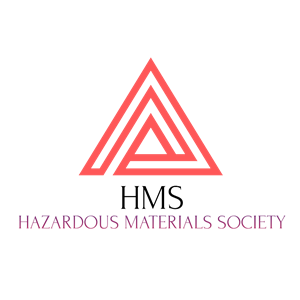
HAZARDOUS MATERIALS SOCIETY
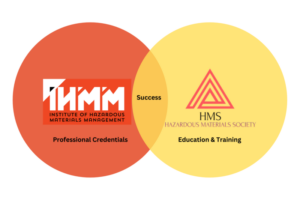
IHMM and HMS
The graphic to the left illustrates the relationship between IHMM and HMS. IHMM formed HMS to serve IHMM’s certificants. IHMM offers a variety of professional credentials and HMS creates education and training programs to serve the applicants and certificants of those credentials.

NPETE HazMat Training Courses for 2025
Some of these courses are 24 hours long and approved for 24 IHMM CMPs; some are 8 hours long and approved for 8 IHMM CMPs and are FREE to attend. They are available only as in-person training.
The May 20-22, 2025 programs with IHMM you may register directly with IHMM. For other venues, registrations contact Mr. Raymond Davis, CHMM, IHMM Fellow, NPETE US DOT PHMSA HMIT Grant Project Coordinator/Instructor at [email protected]
| May 20, 2025 | Rockville, MD In Person | ||
| May 21, 2025 | Rockville, MD In Person | ||
| May 22, 2025 | Rockville, MD In Person |
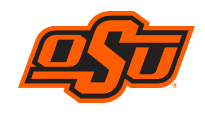
Oklahoma State University Becomes an HMS Training Partner
IHMM is pleased to announce that Oklahoma State University’s College of Engineering, Architecture, and Technology [CEAT], has become an HMS Training Partner. OSU brings its Environmental Management Certificate Program to us, which runs April 7-11, 2025.
| April 7-11, 2025 | OSU-Tulsa, OK |
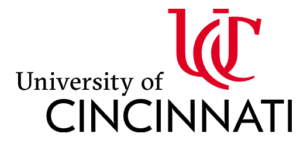
University of Cincinnati, OSHA Training Institute, IHMM, and HMS’ New Training Partner Offers Courses for 2024
| Daily | Online |
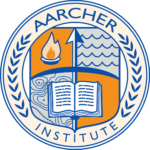
Aarcher Institute, IHMM, and HMS’ Training Partner Offers Courses for 2025!
| Jan 21-22, 2025 | Online and In-Person | |
| Feb 4-7, 2025 | Online and In-Person | |
| Feb 19-20, 2025 | Online and In-Person | |
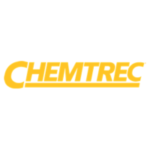
CHEMTREC, HMS Training Partner, Adds Courses for IHMM Certificants
This week CHEMTREC has added its HAZWOPER 8-hour Refresher Training to the HMS Daily Training schedule. This HAZWOPER 8-hour Refresher Training is designed for individuals who need to refresh their existing 24-hour or 40-hour HAZWOPER certification. This course meets the requirements outlined in OSHA 29 CFR 1910.120 for 8 (eight) hours of annual refresher training for workers involved in the transport, storage, or handling of hazardous materials or hazardous waste.
See the CHEMTREC HAZWOPER 8-hour Refresher Training here!
CHEMTREC, an HMS training partner, has had 7 courses approved in advance for earning IHMM recertification certification maintenance points. We are pleased to promote these programs as reviewed and approved by the HMS Education and Training Committee. Thank you CHEMTREC, and thank to HMS’ Education and Training Committee.
| Daily | Ground Transportation for Carriers | Online |
| Daily | OSHA Hazard Communications Standard | Online |
| Daily | Shipping Lithium Batteries and Cells Training | Online |
| Daily | Hazmat General, Safety and Security Awareness Online Training Course | Online |
| Daily | IATA Dangerous Goods Online Training for Operations | Online |
| Daily | 49 CFR Training | Online |
| Daily | IATA Dangerous Goods Online Training for Operations Personnel | Online |
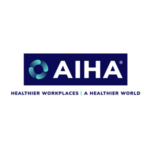
AIHA, HMS Training Partner, Adds Courses for IHMM Certificants
American Industrial Hygiene Association [AIHA] an HMS training partner, has added its first of many courses approved in advance for earning IHMM recertification certification maintenance points. We are pleased to promote these programs in support of IHMM certificants holding the CHMM, CHMP, CSHM, and CSMP credentials. Thank you, AIHA.
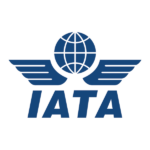
IATA, HMS Training Partner, Adds Courses for IHMM Certificants
IATA, an HMS training partner, has had 3 more courses approved in advance for earning IHMM recertification certification maintenance points. We are pleased to promote these programs as reviewed and approved by the HMS Education and Training Committee. Thank you IATA and thank to HMS’ Education and Training Committee.
Thank you, IATA for contributing programs enabling IHMM certificants to engage in professional development and earn important CMPs!

Bowen EHS, HMS Training Partner, Adds Courses for IHMM Certificants
Bowen EHS, an HMS training partner, has had 4 courses approved in advance for earning IHMM recertification certification maintenance points. We are pleased to promote these programs as reviewed and approved by the HMS Education and Training Committee, chaired by Diana Lundelius. Thank you Bowen EHS and thank to HMS’ Education and Training Committee.
Thank you Bowen EHS for contributing programs enabling IHMM certificants to engage in professional development and earn important CMPs! All three of the new Bowen EHS programs are available online and on demand.
| Daily | Online | |
| Daily | Online | |
| Daily | Online | |
| Daily | Online |
.
Thank you Bowen EHS for contributing programs enabling IHMM certificants to engage in professional development and earn important CMPs! All three of the new Bowen EHS programs are available online and on demand.
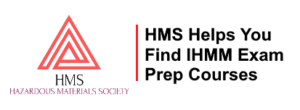
Easily Find Courses to Help You Pass IHMM Credential Exams
A core mission of HMS is education and training. Part of that mission includes assembling the best and most effective courses to assist IHMM applicants in passing their IHMM credential exams.
CDGP® Prep Course
CE-1112: CDGP® Exam Prep – Columbia Southern University – Available On Demand
CHMM® Prep Courses
- AHMP NEACHMM EHMM Course Feb 27 – Apr 3, 2025
- Daily – CHMM® Online Review – Bowen
- Daily – CHMM® Prep Course – Institute of Safety & Systems Management
- Daily –Certified Hazardous Materials Managers (CHMM®) Exam Prep – SPAN Exam Prep, Division of ClickSafety
CSHM™ Prep Courses
CSMP™ Prep Courses
IHMM and HMS Tie Exam Preparation Together for Applicants
Every IHMM certification that requires an examination has a section of its website entitled Examination Preparation.
Connected to the Examination Preparation panel is a companion panel that is Find a Course to Prepare for the Exam.
You see the Find a Course to Prepare for the Exam panel from the CHMM site at left.
When you click on the Find a Course to Prepare for the Exam panel it takes the applicant directly to the HMS site where all CHMM prep courses may be found and chosen.
For the 480 CHMM applicants IHMM had on December 31, 2024, all 480 applicants looking for CHMM prep courses could see and choose their favored CHMM exam prep course. If your course is not on the HMS platform, none of the 480 CHMM applicants could find you.
If you want your CHMM prep course on the HMS platform so it can be found by IHMM CHMM applicants, contact Gene Guilford at [email protected]
HMS Makes Finding Courses to Earn CMPs Easy
Every year more than 1,600 IHMM certificants have to recertify their credentials, evidenced their continuing commitment to improvement and learning to elevate their professional credential.
Earning Certification Maintenance Points [CMPs] is illustrated under Recertification of Your Credential, that includes the Recertification Claims Manual – Appendix A, that details all of the ways a certificant may earn CMPs > https://ihmm.org/recertification-claims/
Having mastered that manual, how does an IHMM certificant find courses to earn CMPs?
HMS has made that simple and easy.
- Go to https://hazmatsociety.org/education-training/
- Scroll down until you see a row of buttons…click on the CMPs button

The system will then generate all of the courses on the HMS E&T platform with IHMM CMPs already attached.
The next developments by the HMS E&T committee will refine available courses’ CMPs by individual credential!
HMS Certified Dangerous Goods Professional [CDGP] Exam Prep
The Columbia Southern University/HMS CDGP prep course is found here on the Hazardous Materials Society [HMS] education and training website > https://hazmatsociety.org/training/ce-1112-cdgp-exam-prep/2022-02-02/
The CSU CDGP exam prep course is delivered entirely online and may be initiated by any CDGP applicant at any time. The CDGP applicant has up to 10 weeks to complete the prep course, though an extension of the 10 weeks may be requested from CSU directly. The CSU CDGP exam prep course contains 8 modules covering the 4 principle texts involved in the CDGP exam, as follows:
- UN Recommendations on the Transport of Dangerous Goods, and
- International Civil Aviation Organization’s Technical Instructions (ICAO TI), and
- International Air Transport Association’s Dangerous Goods Regulations (IATA DGR), and the
- International Maritime Organization’s Dangerous Goods Code (IMDG Code).
More information on the IHMM Certified Dangerous Goods Professional [CDGP] credential may be found here > https://ihmm.org/cdgp/
Donate to HMS
One of the most important projects of the Hazardous Materials Society is our Scholarship Program.
HMS wants to make it as easy as possible for those who cannot always afford to participate in pursuing certification, or keeping up with professional development, or attending great conferences and receiving outstanding training. HMS does not solicit contributions from the general public. HMS does ask IHMM’s certificants and their companies and our education and training vendors to consider a contribution.
Here, through your generosity, you can make a difference in promoting the ability of those who can afford it least to become participants in our communities of practice.
It’s never too late to make a difference, so don’t let this opportunity to make a difference pass you by. Please consider a tax-deductible donation of $250, $500 or what you can to help build HMS’s effort to help others in our communities of practice.
Member Benefits of Hazardous Materials Society
99% of IHMM certificants are aware of the Hazardous Materials Society, which we appreciate. IHMM established the Hazardous Materials Society in order to support and provide services to IHMM certificants.
Did You Know?
Your company’s membership dues for Associate Membership in the Hazardous Materials Society (HMS) are 100% tax-deductible and your participation directly supports scholarship and education/training opportunities for professionals working in hazmat and EHS. Joining as an Associate Member expresses your commitment and your company’s leadership in giving back to our professional community. Join today to claim your tax deduction for the 2020 tax year while expressing your company’s professional affiliation and accessing tools for your marketing and business development plans.
As an IHMM certificant, you pay no dues to take advantage of IHMM’s Foundation at HMS. We do appreciate IHMM’s certificants encouraging their companies to contribute.
To learn more about what HMS is doing now and what they are planning for the future, please see the new Member Benefits page here.

The Hazardous Materials Society [HMS] is a partner of Columbia Southern University.
Columbia Southern University is an online university based in Orange Beach, Alabama, that strives to change and improve lives through higher education by enabling students to maximize their professional and personal potential.
A subsidiary of Columbia Southern Education Group, CSU offers online degree programs at the associate, bachelor, master, doctorate or certificate levels in a multitude of areas such as occupational safety and health, fire administration, criminal justice, business administration, human resource management, health care administration and more. CSU also features undergraduate and graduate certificate programs to provide focused training in specialized areas for adult learners.
Benefits of a CSU Learning Partnership:
- 10% Tuition Discount
- Exclusive Scholarships
- Waived Application and Evaluation Fees
- Access the Career Services Department
For further assistance or additional information, contact Ernie Smith, [email protected]u, or call 251-923-4055
IHMM has a companion organization for which education and training programs are presented and delivered. The Hazardous Materials Society is IHMM’s Professional Association and HMS’ education and training website can be found here. These events are produced independently of IHMM, and their providers have no access to IHMM certification examinations or program information other than that which is publicly available.
IHMM AFFILIATIONS
9210 Corporate Boulevard, Suite 470
Rockville, Maryland, 20850
www.ihmm.org | [email protected]
Phone: 301-984-8969 | Fax: 301-984-1516






